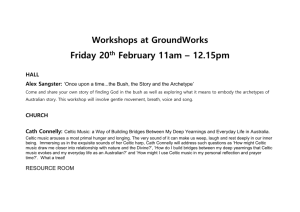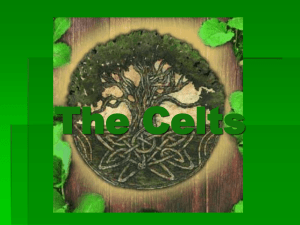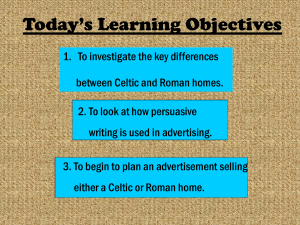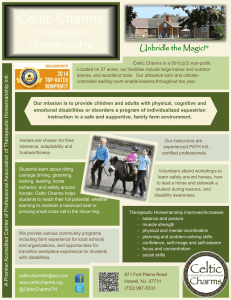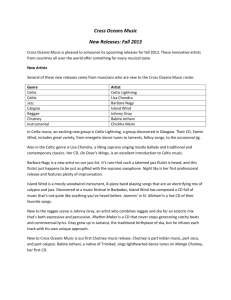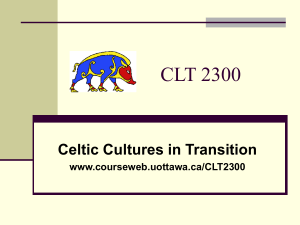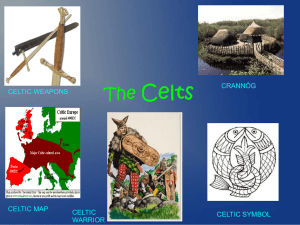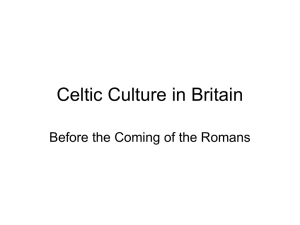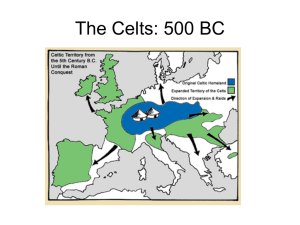CRAMLAP Celtic, Regional, and Minority Languages Abroad Project
advertisement
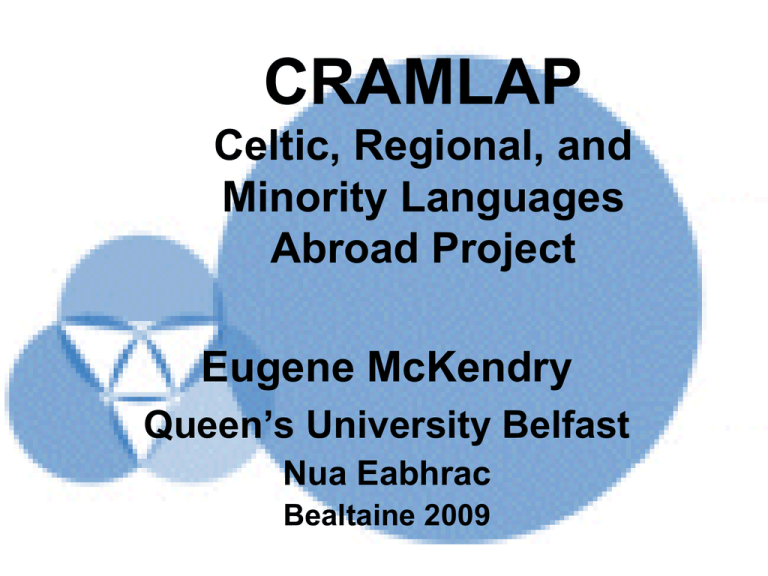
CRAMLAP Celtic, Regional, and Minority Languages Abroad Project Eugene McKendry Queen’s University Belfast Nua Eabhrac Bealtaine 2009 Setting the Scene Context • European Commission adopted an Action Plan Promoting Language Learning and Linguistic Diversity for the period 2004-2006 • The three key areas for action outlined in the plan were: – Extending the benefits of life-long language learning to all citizens – Improving language learning – Creating a more language-friendly environment. 3 Project • The Commission invited proposals for two-year long projects • Seven Europe-wide projects promoting language learning and linguistic diversity were successful • One of the successful proposals was CRAMLAP, Celtic, Regional, and Minority Languages Abroad Project • Aim – to research the transnational provision of Regional and Minority Languages (RMLs) abroad in Higher Education • RMLs in this project are those which are not the national language of another country (with the exception of Irish) 4 Partners • Queen’s University Belfast Eugene McKendry (Project Coordinator) Steve Walsh • Mannheim University George Broderick Martina Müller • National University of Ireland Maynooth Ruairí Ó hUiginn Anne Gallagher • Université de Haute Bretagne, Rennes Gwendal Denis • Oslo University Jan Erik Rekdal • Uppsala University 5 Mícheál Ó Flaithearta Approach Objectives (1) • To conduct an audit of transnational higher education provision for RMLs in Europe • To establish a transnational network to work in collaboration on teaching and learning RML languages • To provide an innovative approach to the delivery of the subject • To produce papers on language teaching and learning 7 Objectives (2) • To develop collaboration for delivery of the subject on a wider scale • To research ways to disseminate information from the higher education environment to other domains, for example, providing information and support on minority and regional languages for policy makers as well as in pre-university and lifelong education • To incorporate the particular global experience of Teaching English as a Second or Other Language (TESOL) into good practice in teaching RMLs in Higher Education 8 Project Meetings • The activities undertaken to achieve these objectives included regular transnational meetings of the project partners • Common and particular tasks were assigned to partners and monitored regularly via the website partners’ area, e-mail and at the meetings • These meetings provided the main opportunities to share, discuss and develop pedagogical and didactic approaches and to ensure an effective progression of the project 9 Technology • Information and Communication Technology (ICT) was used to maintain contact during the project through email and the project website and forum • The CRAMLAP website (http://www.cramlap.org/) is an important element of the project • On the website a private “CRAMLAP Partners” area can be found as well as several public sections • The website will be used on an ongoing basis to disseminate information about provision of Higher Education CRML courses internationally and to exemplify, demonstrate, and disseminate information on potential and good practice for language teaching 10 Methodology: Approaches to Celtic in HE Abroad • Three General Approaches – Philological/ Linguistic – Communicative – Cultural 11 Methodology - Celtic • Surveyed European HE institutions offering Celtic Languages – Questionnaire One dealt with Language provision, staff levels, and research interests. On the whole this is empirical and quantitative data which is now available on the website – Questionnaire Two dealt more with methodology. It sought information on approaches to teaching and learning. The data is more personal and was analysed by the project partners and presented as a paper12 Methodology – Other Regional & Minority Languages • Surveyed European HE institutions offering RMLs (multi-lingual forms) • Considerable debate about which languages should be investigated. Final decisions based on a number of sources • One questionnaire as, unlike Celtic, the earlier forms and the philological approach were not considered relevant. The questionnaire was divided into two sections similar to the separate Celtic questionnaires 13 Surveys 14 Results of Surveys (1) A comparison of the data from both surveys corroborates the results from each. Common points of note are: – Small numbers of students for many languages – Mostly taught by individuals, rather than departmental teams – Teachers are academic subject specialists, with an academic research background, or Post-graduate tutors often on short-term foreign lector contracts (1-2 years) – Limited teacher training – Inadequate or inappropriate textbooks and resources; however, the range of resources is considered to be improving 15 Results of Surveys (2) – Varied class contact times – Limited uptake of European Union schemes – Languages supported by finance or exchange programs, such as Catalan or Irish, are most commonly offered – RML courses are most frequently available as a minor element of a degree course – Doctoral courses are available in many institutions – Cognate languages are important in encouraging uptake: Catalan in Spanish departments, Welsh in Brittany etc. See website for further details of surveys 16 Methodology – Approaches to Language Teaching and Learning – Papers on Theory and Practice were produced – A reflective practice approach was promoted. Issues of general pedagogy and good practice in Higher Education teaching were discussed, leading to implementation through exemplars – Active Learning was promoted through exemplars of Task Based Language Learning (TBLL) 17 Methodology - Website • Professional looking website used to display all data collected • All papers accessible via website 18 Project Outcomes List of European HE Institutions offering Celtic • Surveys sent to all relevant HE institutions • Online form or paper form • Online data automatically added to database • Tables of provision created and displayed on web • Updated when necessary 20 Online List of European HE Institutions offering Celtic 21 Survey Data 22 List of European HE Institutions offering other Regional and Minority Languages • Surveyed European HE institutions offering regional and Minority Languages • Our own list – unlikely we have captured all • Tables of Institutions contacted and our estimate of their provision displayed on web • Needs to be verified by Institutions 23 List of European HE Institutions offering other Regional and Minority Languages 24 Survey Data 25 Papers • Papers on Policy and Practice in Teaching and Learning Languages in Higher Education • Papers on Theory and Research in Language Teaching and Learning 26 Papers – Available on the Web 27 Exemplars • The exemplars provide a set of recipes for language teaching. Those recipes are based on sound principles of teaching and learning. They are designed for teachers to adapt to suit their local contexts • They can be used with a variety of learners and contexts – beginners, intermediate, advanced learners at third-level, second-level; in small groups or one-to-one tuition – and they cover the four language skills (reading, writing, listening, and speaking), as well as the systems (grammar, lexis and phonology) 28 Exemplars 29 Exemplars • The tasks are student-centred and provide for a high degree of student autonomy • Include a certain amount of cognitive challenge designed to increase motivation and stimulate thinking • Most tasks involve a degree of problem-solving • Manipulation of the target language is considered central to acquisition • Some tasks allow skills integration so that reading, writing, listening and speaking are practised through the use of tasks which naturally involve their use • The essential theoretical characteristics of the approach are based on a socio-cultural tradition which stresses the need for dialogue, for negotiation, for interaction with others and for collaborative meaning-making 30 Approaches to Assessment • An overview of current approaches to assessment was discussed and can be found on the website • Particular attention was paid to the Common European Framework of Reference, and two diploma syllabi for adult learners of Irish produced by a CRAMLAP partner were presented to partners ( these now marketed by NUI Maynooth as Teastas Eorpach na Gaeilge) • They were translated into English and posted on the website for wider dissemination and as 31 possible models for other languages Additional Documents Testing Language Skills and the Common European Framework of Reference for Languages (extract) The requirements and expectations of Higher Education students should be considered, particularly those following courses where the linguistic and grammatical aspects are emphasised. In such circumstances, the skill of reading is likely to prove as equally motivating as speaking. Grammar should be taught as required in communication. However, since the context is Higher Education, students are likely to expect and prefer clear structural guidance and understanding, and so the role of grammar must be considered carefully. While some versions of Communicative Language Teaching have underplayed the role of grammar, this approach is unlikely to be successful in university, and this is reflected in the responses from CRAMLAP’s Celtic Studies questionnaires. An eclectic approach to language teaching, combining communication and structure, is more likely to prove successful than a simple exposure to transactional scenarios. 32 While the CEFR has less focus on mechanical grammar practice, The Framework cannot replace reference grammars or provide a strict ordering (though scaling may involve selection and hence some ordering in global terms) but provides a framework for the decisions of practitioners to be made known. (CEFR 2001: 152) The particular grammatical and idiomatic individuality of the language must be incorporated. So, in the Celtic languages, the pedagogy will recognise the importance for students to be able to manipulate prepositional structures and idioms such as “Tá X orm - I am X”; “Y mae X gen i – I have X”. Similarly, the mutation system, so characteristic of Celtic languages, must be explained and practised, orally and in writing. Apparently simple functions and notions such as asking where one lives and how many are in one’s family involve particular idiomatic and structural knowledge in Irish which must be factored into teaching and learning. 33 Website • The website is the tool we use to display and disseminate all the other outcomes • Important it looked professional but content is even more important 34 CRAMLAP site • Important that the information about Celtic and other Regional and Minority Languages in HE in Europe is correct, [up-to-date and relevant] • Site is being regularly accessed • Queen’s has agreed to maintain the site • [However, we need input from HE institutions to keep it correct and relevant] • [Will be contacting all listed HE institutions to promote the site and ask them to verify their details] 35 Dissemination • Dissemination of the project and its outcomes has been a core aim • Methods – Presentations at relevant conferences – Academic Papers – Leaflet – Letter & leaflets sent to all HE Institutions listed as providing either Celtic or other RMLs – Registered with relevant databases/search engines 36 – Presentations to EU Exit Strategy • Dissemination will continue • Maintenance of the lists of institutions offering courses, and any further exemplars and discussion papers, will continue beyond the end of the project period • The website will be maintained by Queen’s University Belfast Information Services • A researcher will hopefully be employed by NICILT and the School of Education for a period annually to research and update the lists 37 Follow Up? Survey of Fulbright and other institutions in USA etc. 38 Contact Details • The main contact for the project is: Dr Eugene McKendry (Director, NICILT) School of Education Queen’s University Belfast 69-71 University Street Belfast BT7 1HL Northern Ireland United Kingdom e.mckendry@qub.ac.uk www.cramlap.org 39
